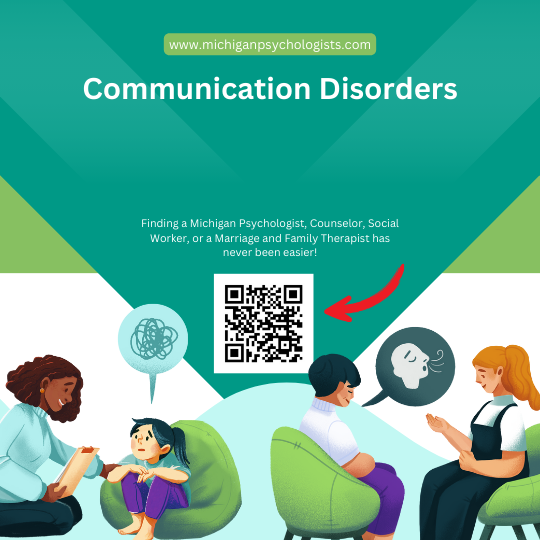Communication Disorders
Home » Guide to DSM-5-TR Mental Health Disorders and Diagnostic Categories » Communication Disorders

Table of Contents
Communication Disorders, as described in the DSM-5-TR, encompass a range of conditions characterized by difficulties in speech, language, and communication. These disorders can affect an individual’s ability to understand, detect, or apply language and speech to engage in conversations effectively.
Types of Communication Disorders
Language Disorder
Diagnostic Criteria
Language Disorder is characterized by persistent difficulties in the acquisition and use of language across modalities due to deficits in comprehension or production. These difficulties are evident in vocabulary, sentence structure, and discourse. The onset of symptoms occurs in the early developmental period, and the difficulties are not attributable to sensory impairments, motor dysfunction, or other medical or neurological conditions.
Associated Features
Children with Language Disorder often have a family history of language-related disorders. They may exhibit delayed language milestones, such as first words or sentences, and may struggle with expressing themselves and understanding others.
Severity Levels
Severity is based on the impact on functional communication, which can range from mild to severe. Mild cases may involve difficulties that slightly impair communication, whereas severe cases significantly hinder the ability to communicate effectively.
Speech Sound Disorder
Diagnostic Criteria
Speech Sound Disorder involves persistent difficulty with speech sound production that interferes with speech intelligibility or prevents verbal communication. The difficulties are not due to congenital or acquired conditions such as cerebral palsy or cleft palate. The onset is in the early developmental period, and the disorder significantly impacts social, academic, or occupational performance.
Associated Features
Individuals may display a limited phonetic repertoire and may omit, substitute, or distort sounds. These speech sound errors can affect their ability to be understood by others and may lead to frustration and social withdrawal.
Severity Levels
Severity ranges from mild, with minor errors and minimal impact on intelligibility, to severe, where speech may be largely unintelligible to most listeners, requiring intensive speech therapy and support.
Childhood-Onset Fluency Disorder (Stuttering)
Diagnostic Criteria
Childhood-Onset Fluency Disorder is characterized by disturbances in the normal fluency and time patterning of speech. These disturbances include sound and syllable repetitions, sound prolongations, broken words, audible or silent blocking, circumlocutions, words produced with an excess of physical tension, and monosyllabic whole-word repetitions. The onset is in the early developmental period, and the disturbances cause anxiety about speaking or limitations in effective communication.
Associated Features
Individuals with stuttering may develop secondary behaviors such as eye blinks, facial grimacing, or other motor movements associated with speech attempts. Anxiety and avoidance of speaking situations are common.
Severity Levels
Severity can range from mild, with occasional disruptions in fluency, to severe, where speech is frequently disrupted, leading to significant avoidance of speaking situations and communication impairments.
Social (Pragmatic) Communication Disorder
Diagnostic Criteria
Social Communication Disorder involves persistent difficulties in the social use of verbal and nonverbal communication. These difficulties include deficits in using communication for social purposes, impairment in changing communication to match context or the needs of the listener, difficulties following rules for conversation and storytelling, and challenges understanding implicit or ambiguous language. The onset is in the early developmental period, and the deficits are not better explained by another mental disorder or medical condition.
Associated Features
Individuals may have difficulties understanding jokes, idioms, metaphors, and other forms of figurative language. They may also struggle with understanding social cues and responding appropriately in social interactions.
Severity Levels
Severity is based on the impact on social interactions and relationships. Mild cases may involve minor social communication difficulties, whereas severe cases can lead to significant impairments in forming and maintaining social relationships.
Unspecified Communication Disorder
Diagnostic Criteria
Unspecified Communication Disorder is diagnosed when symptoms characteristic of communication disorders cause significant distress or impairment in social, occupational, or other important areas of functioning but do not meet the full criteria for any of the specific communication disorders. This category is used when the clinician chooses not to specify the reason that the criteria are not met for a specific communication disorder.
Associated Features
Individuals may present with a variety of symptoms that impact their communication abilities but do not align perfectly with the criteria for a specific disorder. This diagnosis allows for flexibility in acknowledging communication difficulties without fitting them into a more defined category.
Severity Levels
Severity is determined by the overall impact of the symptoms on the individual’s daily life and functioning, and it varies widely based on the specific manifestations of the disorder.
Assessment and Intervention
Comprehensive Assessment
Diagnosing Communication Disorders requires a thorough assessment, including clinical evaluation, standardized testing, and observation of communication in various contexts. Speech-language pathologists often conduct these assessments to determine the nature and extent of the communication difficulties.
Individualized Intervention
Intervention strategies must be tailored to the individual’s specific needs and strengths. This can include speech therapy, language intervention programs, social skills training, and support for related academic and occupational challenges.
Family and Environmental Support
Involving family members and caregivers in the intervention process is crucial for supporting the individual’s communication development. Creating a supportive and enriched communication environment at home and in educational settings can significantly enhance the effectiveness of interventions.
Communication Disorders, as described in the DSM-5-TR, encompass a range of conditions that impact an individual’s ability to communicate effectively. Understanding the diagnostic criteria, associated features, and severity levels of these disorders is essential for providing appropriate assessment and intervention. With targeted support and intervention, individuals with Communication Disorders can improve their communication skills and overall quality of life.